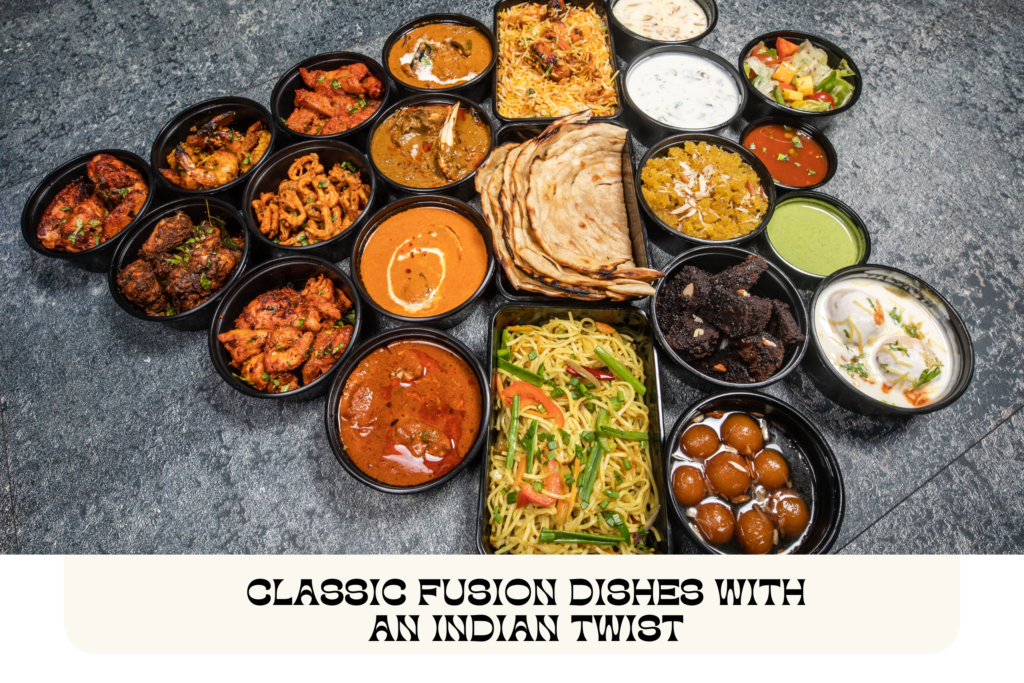In recent years, culinary boundaries have blurred, giving rise to exciting fusion cuisine that combine flavors from various cultures. Blending Indian spices, techniques, and flavors with international ingredients or styles has become a worldwide culinary trend, creating a unique dining experience. Here, we’ll explore some popular fusion dishes and delve into how Indian and international foods can harmonize to satisfy a diverse palate.
1. The Rise of Fusion Cuisine
The culinary world is ever-evolving, and in recent years, a fascinating trend has taken the food landscape by storm – the rise of fusion cuisine. The goal is to bring together ingredients and techniques from two or more distinct culinary traditions to create a harmonious and delightful meal. In India, with its rich tapestry of regional flavors and spices, chefs have been particularly innovative in incorporating global influences to suit local tastes, creating dishes that have appeal across cultural lines.
Fusion cuisine has a rich history that dates back to ancient civilizations. Trade and migration between countries and cultures have led to the exchange of ingredients, spices, and cooking techniques, resulting in the development of fusion cuisine.
2. Classic Fusion Dishes with an Indian Twist

Here are some well-loved fusion cuisines that showcase the delightful marriage of Indian flavors with global favorites:
– Paneer Tacos: Imagine the traditional Mexican taco, but with a flavorful twist. Spiced paneer (Indian cottage cheese) replaces the typical filling, marinated in Indian spices like cumin, coriander, and turmeric, and then grilled. Paired with fresh veggies and a mint chutney, these tacos offer a burst of flavor that’s both familiar and excitingly different.
– Butter Chicken Pizza: Pizza, a staple of Italian cuisine, gets an Indian makeover with a topping of creamy butter chicken. The rich, tomato-based sauce of butter chicken, combined with mozzarella, makes for an indulgent, spicy, and savory pizza that has become a popular favorite.
– Masala Quesadillas: This Mexican-inspired dish combines the simplicity of a quesadilla with the bold flavors of Indian spices. The filling often includes a mix of vegetables or chicken seasoned with garam masala and other Indian spices, creating a gooey, spicy delight that’s hard to resist.
– Curried Pasta: A twist on the Italian classic, curried pasta incorporates creamy tomato-based Indian curry with pasta varieties like penne or spaghetti. Adding vegetables like bell peppers and spinach, along with a hint of cumin and coriander, this dish strikes a balance between Indian and Italian flavors.
3. Asian-Inspired Indian Dishes
Fusion doesn’t just mean blending Western foods with Indian cuisine; it also includes other Asia influences:
– Tandoori Sushi: Japanese sushi rolls with a tandoori twist have been a hit in many places. Tandoori-spiced shrimp or chicken, wrapped in sushi rice and nori, combines the umami of sushi with the smokiness of tandoori spices. The dish often comes with a side of wasabi chutney, blending flavors from India and Japan seamlessly.
– Schezwan Dosa: This fusion food combines India’s favorite south Indian dish, dosa, with the bold flavors of Schezwan sauce from China. The dosa, a thin rice crepe, is filled with a spicy Schezwan-flavored stuffing, giving it an Indo-Chinese twist that’s both crispy and spicy.
– Momos with Indian Chutney: Originally a Tibetan dish, momos have been embraced all over India. These dumplings, often stuffed with vegetables, chicken, or paneer, are served with tangy and spicy Indian chutneys that elevate the flavor of these soft, juicy dumplings.
4. Western Dishes with a Subtle Indian Touch
Sometimes, subtle infusions of Indian spices can turn a familiar Western dish into something unique:
Another one that i can think of is empanada a south american spanish baked pastry with filings similar to samosa we can easily add our own indian fillings or retain the original non veg fillings and add our indian spices to it.
Every year you see trends popping up on the food scene, Cauliflower rice, Zucchini noodles, Kombucha and so on, some stay and some vanish with time. However there are certain foods that have stood the test of time, not just for a few years but thousands of years. One such group of food is Millets. Millets have been grown and consumed for over 10,000 years and India is one of the largest producers of Millets.
5. Bringing Fusion Food into Your Kitchen
Creating fusion food at home can be a fun culinary experiment. Here are a few tips to get started:
– Choose Complementary Flavors: Indian spices are bold and aromatic, so pair them with ingredients that can balance their intensity. For example, creamy bases like cheese or yogurt can tone down spices, making dishes like butter chicken pizza or curried pasta successful.
– Start with Simple Combos: If you’re new to fusion cooking, start with simple combinations. Try adding Indian spices to your everyday Western recipes, like sprinkling cumin on your roasted vegetables or adding turmeric to pasta.
– Experiment with Chutneys and Sauces: Indian chutneys are versatile and can replace traditional condiments. Green chutney can add freshness to wraps and sandwiches, while tamarind chutney can add tanginess to tacos or burgers.
6. Final Thoughts
Fusion cuisine opens up a world of possibilities, blending comfort with excitement, familiarity with surprise. Whether you’re dining out or experimenting in your kitchen, fusion food offers a way to explore different cultures and flavors on a single plate. So, why not try making a butter chicken pizza or masala quesadilla? After all, the best part of fusion cuisines is the chance to be creative and adventurous with your taste buds.
From the streets of Mumbai to New York’s fusion food trucks, the world of culinary innovation is just a bite away!
Category:

Leave a Reply